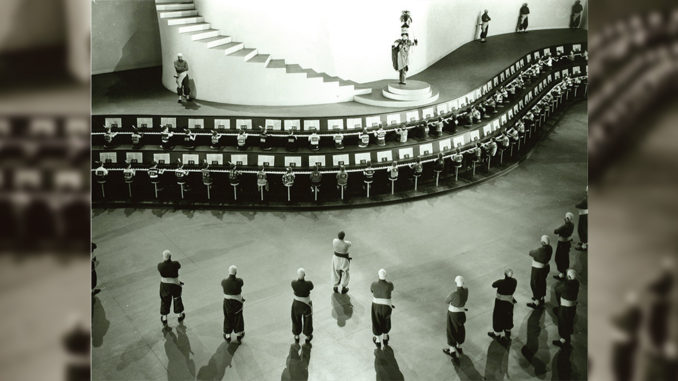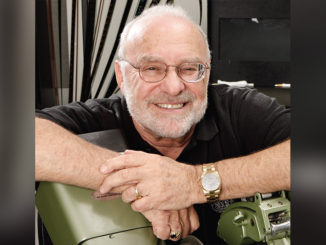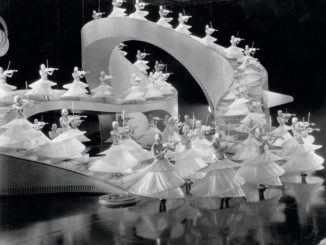
by Kevin Lewis
Musicals in 1953 were sunny, vibrant Technicolor productions starring such wholesome all-American types as Gene Kelly, Howard Keel, Betty Grable, Esther Williams or Jane Powell. They were not dark (though Technicolor) fantasies about kidnapped pre-teen boys imprisoned by a campy Il Duce in underground Gestapo dungeons. But everything about The 5,000 Fingers of Dr. T, released 55 years ago this July, was eccentric and kinky, starting with the odd pairing of composer Friedrich Hollaender (who wrote many of the über-Weimar songs sung by Marlene Dietrich in her early films) and lyricist Theodor Seuss Geisel (aka Dr. Seuss, America’s best-selling children’s author, who also authored the screenplay––his solitary feature film script).
In its time, the film grossed only around one-fifth of its million-dollar-plus budget and was the ultimate reason its producer Stanley Kramer––one of the film industry’s few successful independent producers––lost his releasing contract with Columbia Pictures and began his long association with United Artists. Today, Dr. T is often revived in repertory cinemas and has been brilliantly restored in a DVD release. Because of television showings in the 1960s, the film was rediscovered and developed a cult following among future filmmakers. It directly influenced such films as Chitty Chitty Bang Bang (1969), Tommy (1975), Willie Wonka & the Chocolate Factory (1971), that film’s remake, Charlie and the Chocolate Factory (2005) and other Tim Burton films, and The Simpsons series and movie.
Underlying everything in the film is a fear of diluted masculinity in the Korean War/Eisenhower era.
What constitutes a cult movie? In a narrow sense, it’s a maverick movie with a point of view counter to the mainstream philosophy of its production-release era. Usually, the film was not recognized in its time as a masterwork because it was either ahead of its time or revealed bold truths about its era that audiences rejected. Though the script and lyrics by Dr. Seuss are consistent with his anti-authoritarian philosophy, they are not as pointed or eccentric as one would expect––perhaps because the film had to accommodate the conventions of musicals, and musical fantasy was not the metier of director Roy Rowland.
The bland casting of the real-life husband-and-wife team of Peter Lind Hayes and Mary Healy, as the hypnotized mother and the kid-friendly “white knight” plumber, dates the film and resolutely plants it in the 1950s. Hans Conried, a campy Broadway musical performer famous for the voice of Captain Hook in the Walt Disney animated feature Peter Pan (1953) and Uncle Tonoose on The Danny Thomas Show, is over the top as the mad Dr. Terwilliker. Tommy Rettig as Bartholomew Collins, the troubled boy who tells his woes directly into the camera, represents the best casting.
But when the film focuses on the imprisoned boys, it comes alive. The highlight of Dr. T is the avant-garde modern ballet, choreographed by the esteemed Eugene Loring, of the kidnapped boys in the subterranean bedrock dungeons. Al Clark, who edited such classics as Mr. Smith Goes to Washington (1939) and The Wild One (1953), creates a seamless dance number, which rivals the one by the gang at the beginning of West Side Story (1961). The film would have been truly magical if it had been produced as an animated feature with Dr. Seuss’ illustrations––akin to Gerald McBoing-Boing (1951), the Academy Award-winning animated short also written by Dr. Seuss––rather than the stark expressionistic and surrealistic sets by Cary Odell and Rudolph Sternad.
What constitutes a cult movie? In a narrow sense, it’s a maverick movie with a point of view counter to the mainstream philosophy of its production-release era. Usually, the film was not recognized in its time as a masterwork because it was either ahead of its time or revealed bold truths about its era that audiences rejected.
However, Dr. T reveals––as few others of its era did––the dysfunctional cracks in the post-war little box subdivisions that exploded in the 1960s when those 1950s children became unisex young adults. Underlying everything in the film is a fear of diluted masculinity in the Korean War/Eisenhower era. Like June Cleaver in Leave It to Beaver, the mother cleans her house in pearls and high heels. But she is more unglued than the unflappable June, who was never allowed to bust out all over with her sons, and only made them clean up their room. The single mother in Dr. T is determined to turn her son into a piano prodigy rather than a bat-swinging Beaver. It takes the war veteran/plumber to liberate her, sweep her away in his jeep and allow the boy to escape from the piano with his dog and his baseball bat.
The political message of the musical is mixed. Though the title refers to the ten fingers of five hundred captured boys who are destined to relentlessly play a mammoth piano, it is unclear if the musical is a cautionary fable about fascism or communism. Dr. T’s mission is to stamp out diversity, and his army is old, flabby and seedy. Only pianists will be developed––and violinists, wind instrument players and drummers are all in concentration camps underground. The most Seussian characters are the roller-skating Smith Brothers Siamese twins. Collins is able to defeat Dr. T and save the boys by convincing the doctor that the can of Air Fix he is holding is really the Atom Bomb. Despite the ruse, Dr. T’s fortress blows up after the boys escape.
While at the time Dr. T was a failed musical attempt to challenge the Cold War, interestingly, in the next few years, it was two musical events that began the long thaw between the United States and the Soviet Union: a touring theatrical production of Porgy and Bess that had its Moscow premiere in 1955, impressing the USSR, and Van Cliburn’s winning the First International Tchaikovsky Piano Competition in the Soviet Capital in 1958. And so began the cultural exchange between the super powers that culminated in perestroika.





